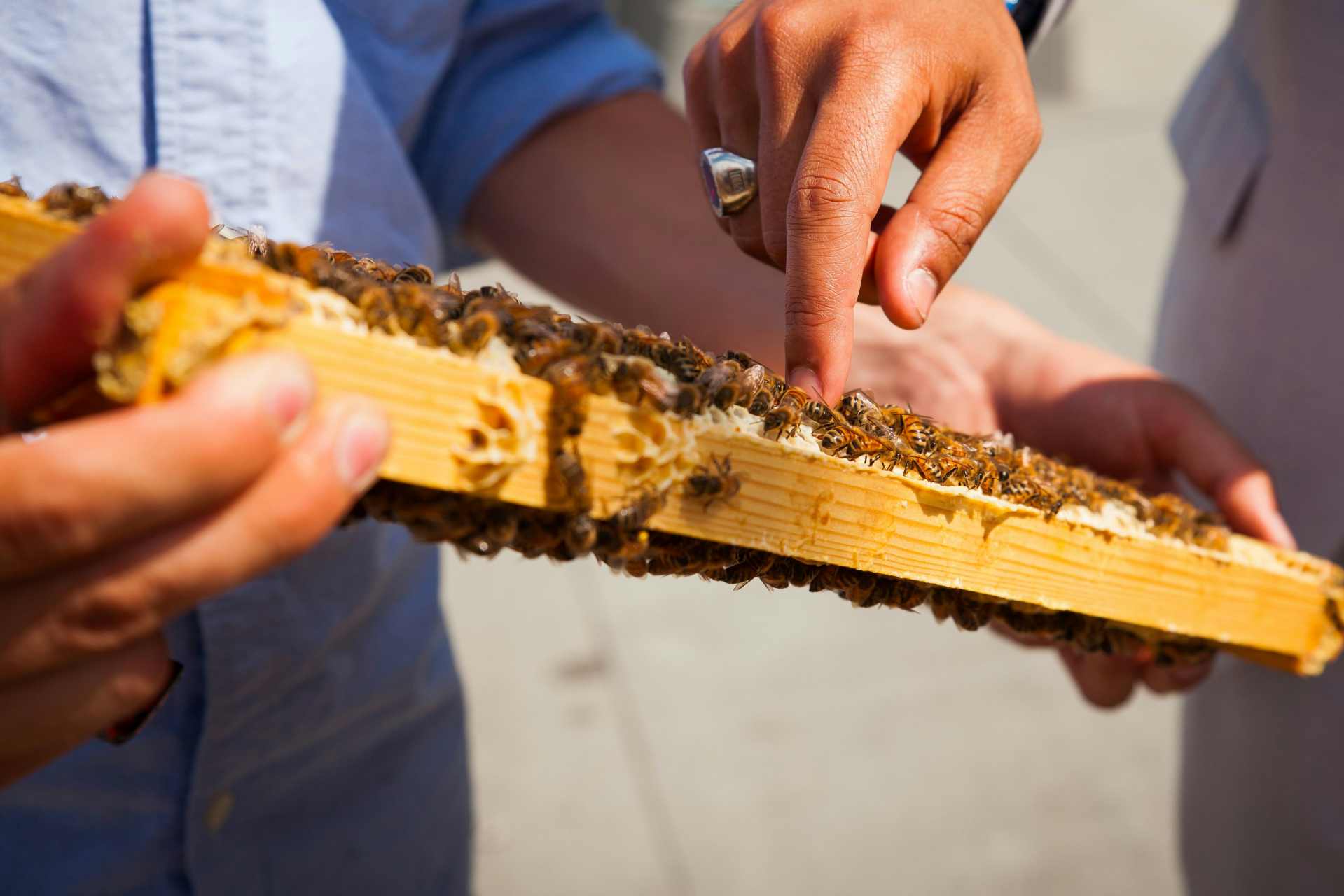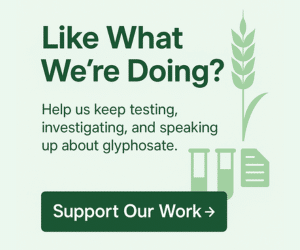In New Zealand, we take tutin contamination in honey seriously — and rightly so.
This naturally occurring neurotoxin, produced when bees forage on honeydew from the tutu plant, has sent people to hospital. In rare cases, it’s been deadly. That’s why there are strict rules: mandatory testing, seasonal limits, and a maximum residue level of just 0.7 mg/kg. We don’t mess around with tutin.
But here’s the strange part: glyphosate, a herbicide classified as a probable human carcinogen by the World Health Organization’s IARC, is turning up in our food too — not just in honey, but in bread, cereal, and even Weet-Bix. And the response?
No mandatory testing. No seasonal harvest rules. And until recently, plans were underway to increase the allowable limits on some of our most common foods — not because the science had changed, but because the residues were getting harder to ignore.
So what gives? Why does New Zealand’s food safety system act quickly and decisively when the danger is acute — but stay largely silent when the exposure is chronic, low-dose, and daily?
This isn’t just a story about two chemicals. It’s a story about how we decide what counts as a risk — and who that decision ultimately protects.
How New Zealand Regulates Tutin Contamination in Honey
Tutin is a naturally occurring plant toxin found in New Zealand. It doesn’t come from chemical spraying or industrial pollution — it’s made by nature itself. But that hasn’t stopped regulators from taking it seriously.
When bees collect honeydew from vine hopper insects feeding on tutu plants, tutin can end up in the honey we eat. And that can be dangerous. Documented poisoning cases in New Zealand have resulted in seizures, hospitalisations — even deaths.
In response, New Zealand introduced some of the strictest food safety controls in the world for tutin. These include:
- A maximum limit of 0.7 mg/kg in honey (lower again for comb honey)
- Seasonal risk windows between January and April
- Mandatory testing or location-based risk management plans for beekeepers operating in high-risk areas
- Ongoing monitoring, guidance updates, and public-facing education
In other words: precaution in action. Even though tutin contamination is rare and unpredictable, the risk was deemed serious enough to warrant clear thresholds, oversight, and mitigation strategies. We didn’t wait for more deaths. We acted.
So what happens when a chemical like glyphosate — a widely used herbicide with global debate over its health effects — ends up in the food supply?
That’s where the contrast becomes harder to ignore.
Chronic Glyphosate Residues: A Hidden Risk in NZ Food
Unlike tutin, glyphosate doesn’t sneak in through nature — it’s sprayed there on purpose.
Used widely in New Zealand agriculture, glyphosate-based weedkillers like Roundup are applied to everything from cereal crops and pastures to roadside verges and orchards. They’re used before planting, during growing, and in some cases — just before harvest. That’s how residues end up in the food we eat.
We’ve seen it firsthand. Our independent testing has already found glyphosate in:
- Honey — despite claims from some producers that it’s free from contamination
- Weet-Bix — one of New Zealand’s most iconic brands
- Supermarket bread and breakfast cereals — items consumed daily by children and families
Yet despite this widespread presence, there is:
- No mandatory testing
- No product labelling
- No restriction during high-risk harvest windows
- And until recently, plans to raise the allowable residue levels (MRLs) on key crops like wheat, barley, and oats
What’s more, glyphosate formulations (not just the active ingredient) have been linked to endocrine disruption, oxidative stress, and gut microbiome changes in multiple peer-reviewed studies. These aren’t always headline-grabbing poisonings like tutin can cause — but they raise long-term questions about chronic, low-level exposure and its cumulative effects.
Still, the regulatory system treats glyphosate very differently. Unlike tutin, which is managed based on worst-case events, glyphosate is managed based on industry expectations: what residues are likely to show up under current use patterns, not what’s safest for the public.
So we’re left with a contradiction:
The rarer, more acute hazard is tightly controlled. The widespread, daily exposure? Tolerated. Even defended.
When Acute Poisonings Prompt Action — and Chronic Exposure Gets a Pass
The difference isn’t just in the chemicals. It’s in the kind of harm they cause — and how we respond to it.
Tutin causes acute poisoning. When someone gets sick from contaminated honey, it’s visible. It’s immediate. There’s a clear cause and effect. People end up in hospital. Regulators respond.
Glyphosate doesn’t work like that. You don’t collapse after eating toast made from sprayed wheat. You don’t go into convulsions after a spoonful of glyphosate-laced honey. But that doesn’t mean there’s no reaction.
Some people do notice symptoms after glyphosate exposure — especially when it’s sprayed nearby. They describe fatigue, headaches, brain fog, joint pain, or feeling generally “off.” One contributor to NoMoreGlyphosate.nz shared this:
“What I feel after the neighbour sprays – pain in my fingers, the headache, then I see the yellowed grass.”
— The Body Remembers: Glyphosate’s Subtle Health Signals
We don’t hear these stories in mainstream reporting. And when it comes to residues in food, the reactions — if they happen — are even harder to trace.
How would someone even make the connection?
A foggy head the morning after porridge. Gut discomfort after lunch. Trouble concentrating. A child’s skin rash.
These symptoms are common. But what if common doesn’t mean harmless?
Another woman shared how she lost her sense of taste and smell for more than two years — a symptom she initially blamed on potatoes, but later linked to glyphosate. After eliminating the suspected trigger from her diet, her senses returned in a matter of days.
“It wasn’t the potato. It was the spray on it.”
→ Read her full story
The science around glyphosate’s long-term effects is still evolving, but concerns include:
- Disruption of the gut microbiome
- Potential links to endocrine disorders and hormone imbalance
- Oxidative stress and DNA damage
- Accumulation in tissues over time
- And increasingly, connections to cancer — not just one, but up to ten types, according to recent legal reviews and toxicological studies
Glyphosate’s association with non-Hodgkin lymphoma has already resulted in billions of dollars in court-awarded damages overseas. But newer research is pointing toward possible links to other cancers too — including leukemia, liver, kidney, pancreatic, and brain cancers. The evidence isn’t settled, but it’s growing. And it’s not going away.
Unlike tutin, glyphosate’s effects are not dramatic. They’re subtle. Slow. Easy to dismiss. And that makes them easier to tolerate — even when they show up in honey.
So while one contaminant triggers a swift regulatory response, the other gets a pass — not because it’s proven safe, but because its harm is harder to see.
Food Safety or Regulatory Convenience? A Question of Standards
New Zealand presents itself as a country that takes food safety seriously. And in some ways, it does. Our approach to tutin contamination shows that — setting strict limits, applying seasonal risk management, and requiring proactive testing before products go to market.
But glyphosate? That’s a different story.
Despite showing up in common foods like honey, cereals, and bread, glyphosate is not subject to mandatory testing. There are no harvest restrictions. No warning labels. No requirement to prove absence. Just Maximum Residue Limits (MRLs) — thresholds that have historically been adjusted to reflect common agricultural use, not necessarily long-term safety.
That’s starting to shift. In October 2025, MPI announced that it would retain the 0.1 mg/kg limit for glyphosate on wheat, barley, and oats — and introduce new restrictions on how glyphosate can be used on those crops. It’s a move in the right direction. But is it enough?
Because here’s the catch: MRLs aren’t designed to protect health in a vacuum. They’re built around assumptions — assumptions about how food is grown, how much is consumed, and how much residue is expected based on current industry practices. When residues start exceeding those expectations, the conversation often shifts — not toward reducing use, but toward raising the limit.
That’s regulatory convenience. Not precaution. Not public protection.
So while MPI’s decision to hold the line on some cereals is welcome, the wider system still leans heavily in favour of industry continuity over cumulative risk reduction. There’s still no routine testing. No monitoring of glyphosate across the broader food supply. No discussion of daily, low-level exposure stacking up across multiple products.
And so we’re left with a deeply uneven landscape:
- A naturally occurring toxin like tutin gets managed before people get sick.
- A synthetic chemical like glyphosate gets managed after residues are already present in the food chain — if at all.
Is that what we mean by food safety?
Or are we just making the rules fit the spray pattern?
Honey, Glyphosate and the Beekeeper’s Dilemma
When glyphosate is detected in New Zealand honey, the blame often lands — unfairly — on the beekeeper. But bees are foragers. They don’t stay inside boundaries. They travel for kilometres across farms, pastures, crops, and roadsides — wherever they can find nectar and pollen. And if those landscapes have been sprayed with glyphosate, the residues can follow them back to the hive.
This isn’t just speculation. We’ve tested local honey and found glyphosate present, despite best practices. The truth is: beekeepers can do everything right and still end up with contaminated honey.
As MPI maintains glyphosate residue limits on cereal crops like wheat, barley, and oats at 0.1 mg/kg, it’s important to remember that bees forage on and around these very crops. What happens in those paddocks doesn’t stay in those paddocks.
So where does that leave consumers? Or the honey industry? Or small-scale beekeepers who pride themselves on purity — only to be caught out by an invisible chemical drifting through the food system?
It raises an uncomfortable question:
What does “healthy honey” really mean — when contamination is out of the beekeeper’s control?
For more on this:
Same Honey, Different Standards: Where This Leaves Us
When tutin is detected in honey, there’s no ambiguity. It’s treated as a serious public health risk. The legal residue limit is 0.7 mg/kg, and beekeepers in high-risk areas must test their product or shift their harvest windows to avoid contamination. The message is clear: honey should be safe, and clean.
Glyphosate also has a legal limit — 0.1 mg/kg in honey. But here’s the difference: even when that limit is exceeded, nothing happens.
We know — because we’ve reported honey samples with glyphosate levels well above the legal threshold directly to MPI. And what was the outcome?
No recall.
No withdrawal from sale.
No warning issued to the public.
In other words, the limit exists — but there’s no consequence for crossing it.
Meanwhile, the blame still tends to fall on beekeepers, even though they can’t control where their bees forage or what crops have been sprayed kilometres away. And consumers are left unaware — buying honey that may be carrying residues above the very limits set by our food safety system.
We’re not saying tutin and glyphosate are the same. One causes acute poisoning. The other may contribute to chronic, long-term harm. But both can end up in the same jar.
So why does one trigger enforcement — and the other gets ignored?
The honey looks the same. The risks aren’t. But maybe it’s time the standards — and the consequences — weren’t either.
Resources & References
We’ve covered a lot — from acute neurotoxins to chronic chemical residues, and the uneasy double standard that separates them. If you want to explore the evidence further, the links below provide essential context: official guidance, real-world stories, and the science behind the inconsistencies.
Managing Tutin Contamination in Honey – MPI
Outlines New Zealand’s regulatory controls for tutin in honey, including seasonal testing requirements and legal residue limits.
Glyphosate Residue Limits to Stay at 0.1 mg/kg – MPI (Media Release)
Details MPI’s decision to retain the existing glyphosate MRL for wheat, barley, and oats, and introduce new use restrictions.
Why Honey Tests Positive for Glyphosate
Explains why beekeepers can’t always prevent contamination, and how bees’ foraging range brings them into contact with sprayed crops.
Healthy Honey. Glyphosate. Contradiction
Raises questions about the contradiction between honey’s healthy image and the reality of chemical residues in the product.
The Body Remembers: Glyphosate’s Subtle Health Signals
Personal stories of real-time reactions to glyphosate exposure — including pain, fatigue, and other symptoms that often go unrecognised.
Lost Taste and Smell from Suspected Glyphosate Exposure
One woman’s account of losing her sense of taste and smell, later linked to glyphosate-sprayed food.
Glyphosate Residues in NZ Honey – First Test Results
Independent testing by NoMoreGlyphosate.nz confirms detectable glyphosate in New Zealand honey, even from respected producers.
Analytica NZ – What You Need to Know About Glyphosate (PDF)
Fact sheet from an IANZ-accredited lab summarising testing methods, detection levels, and residue limits for glyphosate in honey.
The deeper you dig, the clearer it becomes: this isn’t just about one chemical or one crop. It’s about a food safety system that responds swiftly to what’s obvious — and shrugs at what’s accumulating. That’s why we’ll keep asking the uncomfortable questions.
Image Source & Attribution
We’re grateful to the talented photographers and designers whose work enhances our content. The feature image on this page is by Alvéole Buzz. You can find more of their work here: https://unsplash.com/@gettyimages.




